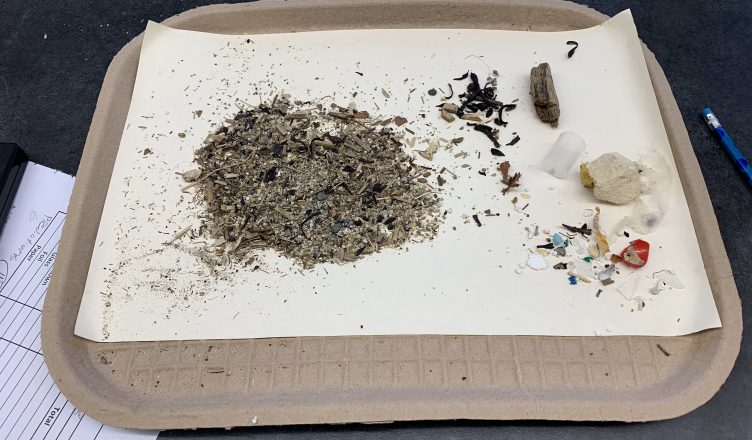Above: Microplastics sorted from a beach sample also containing sand, gravel and other organic material were recorded as part of our microplastics research program.
Microplastics have been in the environmental spotlight over the past few years, emerging as a concerning subset of the larger plastic pollution issue. Microplastics are created when larger plastics break down to a size of 5mm or smaller when tossed around in waves or other elements. They can also be found in some products as microbeads, and can be shed as microfibers from clothing made of artificial fabrics.
The ongoing microplastics research by Blue Ocean Society includes monthly sampling from five different beach sites in New Hampshire from April-October and analysis of the types and abundance of microplastics at each site. Read more about our program and learn how to get involved here!
I attended a workshop this fall hosted by Draper, an engineering company based in Cambridge, MA, designed to bring together leading experts on microplastics to share the most recent research findings in the field. Here’s what I learned!
Microplastics Basics
Here’s some basic, reliable information about microplastics, supported by current science.
- “Macro” plastics, or large products and pieces, will fragment into microplastics through wave action, UV exposure, and other natural elements but do not biodegrade
- Plastic production is increasing around the world
- Recycling rates are currently unknown, but do not equal collection rates of recyclables
- The amount of plastic in the ocean is not known exactly at this time despite some estimates
- Most plastics come from land-based sources rather than at-sea spills
- Plastic have been found in: rivers, lakes, oceans, harbors, and polar ice caps
Contaminants Found on Plastic
Anna-Marie Cook, EPA Subject Matter Expert on Microplastics, shared results from the EPA’s current research into the ways in which plastics can become loaded with contaminants in the ocean. Contaminants categorized as persistent, bioaccumulative and toxic (PBTs) chemicals that run off from urban and agricultural areas into the ocean can latch onto microplastics, accumulating on the surface of the plastic pieces. Recent research has shown 1,000-1,000,000 times higher concentrations of contaminants on plastic than in the surrounding water. These contaminants can then bioaccumulate as they travel up the food chain, meaning that although an individual zooplankton may only have one microplastic particle in their digestive system, a filter feeder such as a eating hundreds of zooplankton may have a much higher concentration of both microplastics and the contaminants on them. The EPA is also conducting research on microplastics found in fish in the North Pacific and South Atlantic Gyres and will expand into research on microplastics throughout the water column. You can read more about their microplastics research here!
Microplastics Solutions: Best Practices from Different Sectors
The workshop wrapped up with a panel in which experts shared their best practices for finding, creating, and sharing solutions to the issue of microplastics pollution. Their advice is paraphrased below.
Eric DesRoberts from the Ocean Conservancy:
- Ask the people in your life to fully understand why we clean beaches and how their daily actions are connected to the ocean, inspiring conscious decision making every day
Rachel Miller from the Rozalia Project:
- The best solutions are ones that consumers can adopt immediately that make a difference now while larger issues upstream and downstream are being addressed over time, encouraging individual action
Dave McLaughlin from Clean Ocean Access Rhode Island:
- Tap into recreational activities or hobbies as a way to connect with people and create community around something they already care about and use that as a vehicle for change toward making what they’re passionate about even better
Pam Greenley from Draper:
- Use a contest or similar event with an award to encourage change and innovation in your community while supporting individuals with recognition for their hard work
Did you learn anything new about our current knowledge of microplastics? Do you have any innovative solutions to this major issue in mind? If you would like to involve your classroom in our microplastics research, you can read more about our newest program here.






